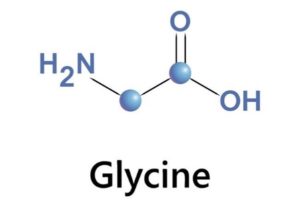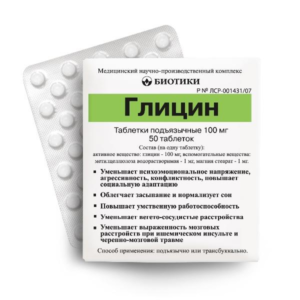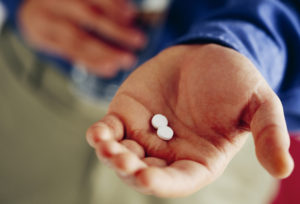Content
- 1 What is glycine for
- 2 Glycine composition
- 3 Useful properties of glycine
- 4 The benefits of glycine for men
- 5 Can I take glycine for pregnant women?
- 6 Is glycine good for breastfeeding
- 7 Why is glycine useful for children
- 8 Dosage and rules for the use of glycine
- 9 Why is there a lack of glycine
- 10 Consequences of glycine overdose
- 11 Contraindications and side effects from taking glycine
- 12 Combination of glycine with other drugs
- 13 Is glycine compatible with alcohol
- 14 Glycine analogs
- 15 Conclusion
- 16 Reviews
Glycine is an organic compound with the formula NH2CH2COOH, belongs to the group of neurotransmitters, and the benefits and harms of glycine depend primarily on compliance with the rules for its use. You can get this substance from the outside from foods with a high protein content (eggs, meat, nuts, cottage cheese), as well as by taking a pharmacological drug of the same name. Aminoacetic acid - this is what the chemical name of the compound sounds like - has become very popular due to its many beneficial properties.

What is glycine for
From a biochemical point of view, it is an amino acid that is produced in the body and actively participates in the regulation of metabolic processes. Often, the body's own synthesis of this compound does not provide the brain's needs at the proper level. The drug helps the body to establish a full-fledged amino acid synthesis, but it should not be taken uncontrollably to avoid possible harm.
Glycine composition
1 tablet of glycine contains 100 mg of aminoacetic acid - the active ingredient - and additionally 1 mg of water-soluble methylcellulose with 1 mg of magnesium stearate. These excipients give the tablet form of the drug the necessary technological properties, do not cause any harm, and do not affect the beneficial effect.

Useful properties of glycine
The tool has a number of useful properties:
- reduces aggressiveness;
- normalizes sleep;
- improves memory;
- reduces disorders resulting from a previous heart attack or stroke;
- relieves intoxication;
- improves performance.
Undoubtedly, the use of glycine as a medicine for the prevention of various diseases.
- Taking glycine helps lower blood pressure levels, which is one of its most prominent properties.
- The use of glycine is also in the reduction of vascular manifestations, including with menopause.
- Interestingly, for athletes, glycine is a popular recovery aid between workouts.
- The benefits of glycine as a means to improve metabolism in the brain are noted.

The benefits of glycine for men
The tool has become quite widespread due to its effectiveness in eliminating problems caused by impaired sexual function in men. It is prescribed by the attending physician if it is determined that problems with potency are associated with a psychological disorder or trauma. The benefits lie in removing toxins from the body, relieving psychological stress before having intercourse, strengthening the walls of blood vessels.
To increase potency, glycine must be taken in a full course to maximize the beneficial effect.

Can I take glycine for pregnant women?
During pregnancy, the drug shows itself well as a sedative. It is prescribed in any trimester, as it does not harm the fetus.
The use of glycine for pregnant women is also in creating favorable conditions for the development of the fetus, reducing the risk of neurological pathology in the child. Regular intake is beneficial for the normal course of pregnancy until delivery.
Is glycine good for breastfeeding
During breastfeeding, aminoacetic acid, due to its beneficial properties, has a positive effect on the processes taking place in the body of a nursing mother. Metabolism is normalized, cognitive processes are improved, and there is also a benefit in regulating the rhythms of sleep and rest.
The treatment course is recommended to be agreed with the doctor. Glycine is prescribed by pediatricians to children under 1 year of age and to nursing mothers. This is due to the absence of proven harm to the mother and child, its production from plant materials and the ingress of only a small amount into colostrum and breast milk.

Why is glycine useful for children
Restlessness, feelings of anxiety are quite frequent phenomena in schoolchildren and preschoolers due to the peculiarities of child physiology and psychology. Regular intake of the neurotransmitter amino acid can help a child painlessly cope with a change of environment and environment, and cope with stress. This is the undoubted benefit of glycine for children.
Quite often, this neurotransmitter is prescribed to hyperactive, absent-minded adolescents. Reception of the drug improves concentration of attention, makes it easier to memorize the material, which has a positive effect on academic performance.

Glycine for babies
For an infant, the drug is prescribed in the following cases: detection of a birth injury, overexcitation, sleep disturbance.
Due to the fact that independent resorption of the tablet form by infants is not possible, half of the tablet must be crushed until a powdery mass is obtained, then dissolved in water at room temperature. Dissolution does not affect properties. In this case, the duration of admission can be up to 4 weeks - this will allow you to evaluate the beneficial effect. The potential harm is assessed by the attending physician: as a rule, it is unlikely, and the potential benefit is much higher than the risks.

Dosage and rules for the use of glycine
Glycine is prescribed by the attending physician individually, after assessing the potential benefits and harms of the drug for a particular patient.
The standard dose is the appointment of 1 tablet 2-3 times a day, and the course of treatment (depending on the diagnosed pathology) can last from 1 week to 1 month and can be carried out several times a year, the interval between courses can be 30 days.
For sleep disorders, for maximum benefit, aminoacetic acid is taken half an hour before bedtime or just before falling asleep, 0.5–1 tablets (dosage depends on age).
The drug is used in tablets or ground to a powder form sublingually (placed under the tongue) or buccal (between the lip and jaw or in the oral cavity until final absorption). The beneficial properties of the neurotransmitter appear the same with any method of administration.

How to drink glycine for adults
The benefits of glycine for the adult body are known.
In case of craniocerebral trauma and ischemic strokes, it is advisable to start taking the neurotransmitter immediately, even before the manifestations of the disease disappear.The recommended useful dose for ischemic stroke is 10 tablets within 3-6 hours after the first manifestation of symptoms of the disease. The first five days after a stroke, you should take 10 tablets, then 3 a day for a month.
For insomnia, the drug is taken half an hour before bedtime or just before bedtime.
For chronic alcoholism or drug addiction, take 2-3 tables. a day for 4 weeks.
The value of aminoacetic acid has also been proven by cardiologists. For the prevention of heart pathologies, the use of glycine is unconditional: it is absorbed in 1 table. in a day.

How to take glycine for children
Before use, consultation with a specialist is required, since, despite the general benefits of aminoacetic acid, the risk of individual intolerance is not excluded. For this reason, you should not carry out the treatment yourself.
The recommended norm for children with reduced working capacity, deviations, developmental delays is 2-3 tables. 2-3 times a day. The course of admission is from 2 weeks to 1 month. Children under 3 years of age are prescribed 50 mg (instead of 100) per day.
If the remedy is necessary for an infant who is experiencing problems with taking pills, then it is prescribed to the mother so that aminoacetic acid enters the infant's body through breast milk.

How much glycine can you drink per day (daily intake)
The most popular dosage regimen for the drug is 1 or 2 tablets 2-3 times a day. In case of sleep disturbance, even 1 tablet will be useful. The daily dose depends on a number of factors, including the age of the patient and the type of disease. Reception in the amount of 6 tablets (2 tablets after meals) is permissible after traumatic brain injury or poisoning with alcoholic beverages.
Why is there a lack of glycine
Lack of glycine in the body is common. Amino acid deficiency affects primarily the nervous system.
Main reasons:
- transferred stress;
- high physical and mental stress;
- lack of sleep;
- bad habits.
Passion for vegetarianism also leads to amino acid deficiency and, as a result, to a decrease in muscle mass, anemia. However, a careful and competent selection of useful products will help to solve problems with obtaining the elements necessary for a full life.

Consequences of glycine overdose
Despite the non-toxicity of glycine and the ability to be excreted well naturally, its abuse can lead to some harm. Most often, these cases occur with children who are attracted by the sweet taste of aminoacetic acid.
With an overdose of glycine (more than 3 g per day), an increase in its sedative properties is observed.
Symptoms:
- dizziness;
- nausea;
- general weakness;
- drowsiness;
- blood pressure decreases.
In the presence of hypersensitivity or a predisposition to allergies, redness of the skin, eyes, runny nose, diarrhea is possible.
Contraindications and side effects from taking glycine
The drug has virtually no contraindications: in terms of properties, it is identical to the amino acid that is produced in the human body. Cases of poisoning with the drug were also not noted.Side effects are recorded extremely rarely: mainly, they are fatigue, allergic manifestations, drowsiness, and a decrease in blood pressure. If one of these signs appears, you should immediately consult a doctor to minimize possible harm.

Combination of glycine with other drugs
The properties of glycine make it possible to combine it with almost all medicines.
When combined with antipsychotic, anticonvulsants, antidepressants, it significantly weakens their activity and reduces the toxic effect.
Is glycine compatible with alcohol
Taking glycine helps to accelerate metabolism and eliminate toxins formed under the influence of ethyl alcohol. The neurotransmitter is used both for chronic alcoholism and for severe consequences of binge drinking as an adjuvant, as well as to eliminate hangover syndrome. The beneficial effect is observed after resorption of two tablets. A maximum of 4 such doses are allowed per day.

Glycine analogs
Glycine has analogues with similar beneficial effects and properties. They include other active ingredients, but the principle of their action is generally the same.
The most popular neurotransmitter analogs:
- Mexidol. It is used to improve brain function and is effective in combating withdrawal symptoms.
- Tryptophan. It is recognized as useful in the treatment of depressive disorders, reduces the harm and severity of alcohol withdrawal.
- Neurotrophin. It is used for discirculatory encephalopathy and has been shown to be beneficial in reducing anxiety.
The benefits and harms of each of the above analogs should be assessed solely on an individual basis, taking into account the diagnosis, the degree of impairment, concomitant pathologies, as well as the properties of other medications taken.

Conclusion
Glycine is included in the list of vital medicines, but before taking it, you need a mandatory medical consultation: a specialist will explain in detail what the benefits and harms of glycine are, and will tell you about the dosage features. The correct prescription of the drug, taking into account all its properties, will help not only improve memory and ensure healthy sleep, but also prevent the occurrence of more serious pathologies that harm the body. Patients with various cognitive disorders, disturbed sleep, anxiety, as well as persons who, by the nature of their activities, often face stress and nervous strain, will be able to appreciate the beneficial properties of this neurotransmitter.


